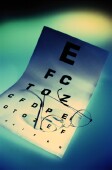Early Screening Improves Outcomes for Kids With Amblyopia
Vision tests before age 2 were more beneficial than those done later, study finds.
|
E-mail this article
Subscribe to news
Printer friendly version
|

(SOURCE: JAMA/Archives journals, news release, April 14, 2008)
THURSDAY, April 17 (HealthDay News) -- Early screening and detection of amblyopia, also known as "lazy eye," may improve visual outcomes for children, a study by Alaskan researchers suggests.
They found that children who screen positive for amblyopia before age 2 seem to have better outcomes than children whose amblyopia is detected between the ages of 2 and 4.
The researchers at Ophthalmic Associates in Anchorage compared post-treatment outcomes in 36 children who were screened before age 2 and 58 children who were screened between 2 and 4.
"Despite similar levels of amblyogenic risk factors, the proportion of children failing to reach a visual acuity of 20/40 was significantly less among those screened before 2 years [5 percent] than in those screened from ages older than 2 years and younger than 4 years [17 percent]," the study authors wrote.
"Very early photoscreening yields better visual outcomes in amblyopia treatment compared with later photoscreening in preschool-aged children," they concluded.
The study was published in the April issue of the Archives of Ophthalmology.
Typical screening for amblyopia consists of visual acuity screening (patients are asked to read letters on a chart) and an examination to detect cataracts, problems with eye alignment and other risk factors for amblyopia, according to background information in the study.
In conventional visual acuity testing, children need to be old enough to cover one eye and read visual charts. For younger children, objective screening for risk factors and newer techniques involving taking photographs of the eye (photoscreening) can be used.
More information
The MedlinePlus Medical Encyclopedia has more about amblyopia.
Copyright © 2008 ScoutNews, LLC. All rights reserved. 
HealthDayNews articles are derived from various sources and do not reflect federal policy. healthfinder.gov does not endorse opinions, products, or services that may appear in news stories. For more information on health topics in the news, visit the healthfinder.gov health library.